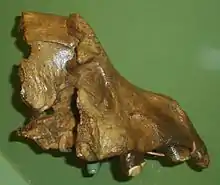Pachycrocuta
Pachycrocuta was a genus of prehistoric hyenas. The largest and most well-researched species is Pachycrocuta brevirostris, colloquially known as the giant short-faced hyena as it stood about 90–100 cm (35–39 in) at the shoulder[1] and it is estimated to have averaged 110 kg (240 lb) in weight,[2] approaching the size of a lioness, making it the largest known hyena. Pachycrocuta first appeared during the late Miocene (Messinian, 7.2 to 5.3 million years ago[3]) and became extinct during the middle Pleistocene, 400,000 years ago.
| Pachycrocuta | |
|---|---|
 | |
| P. brevirostris reconstruction | |
| Scientific classification | |
| Kingdom: | Animalia |
| Phylum: | Chordata |
| Class: | Mammalia |
| Order: | Carnivora |
| Suborder: | Feliformia |
| Family: | Hyaenidae |
| Genus: | †Pachycrocuta Kretzoi 1938 |
| Type species | |
| †Pachycrocuta brevirostris | |
| Species | |
| |
Fossils
The oldest specimens of Pachycrocuta were found in the late Miocene of Baringo County (Kenya).[3] Fossil remains have been found broadly in Eurasia and southern and eastern Africa. Most material consists of fragmented remains, usually of the skull, but a cache of very comprehensive bone material was unearthed at the famous Zhoukoudian site, which probably represents the remains of animals using these caves as lairs for many millennia.[1] At the western end of their former range, at Venta Micena in southeastern Spain, a huge assemblage of Pleistocene fossils also represents a den.[4]

Other proposed species, P. robusta and P. pyrenaica, are less well researched; the former may simply be an exceptionally large European paleosubspecies of the brown hyena, Hyaena brunnea. Sometimes included in this genus (as Pachycrocuta bellax) is the extinct giant striped hyaena, Hyaena bellax.
Behaviour
Similar to the modern day striped hyena, it was probably primarily a kleptoparasitic scavenger of the kills of other predators, such as sabertooth cats.[5] Pachycrocuta scavenged for food, probably preferentially so, because it was a heavyset animal not built for chasing prey over long distances. In this respect it would have differed from the spotted hyena of today, which is a more nimble animal that, contrary to its image as a scavenger, usually kills its own food, but often gets displaced by lions. Apparently it was ecologically close enough to its smaller (but still large) relative Pliocrocuta perrieri that they are never found as contemporary fossils in the same region. Research by anthropologists Noel Boaz and Russell Ciochon on remains of Homo erectus unearthed alongside Pachycrocuta at the Zhoukoudian site attributed scoring and puncture patterns observed on hominin long bones and skulls—originally thought to be signs of cannibalism—to predation by Pachycrocuta.[6]
It has been proposed that Pachycrocuta was outcompeted and driven to extinction by the spotted hyena, which was formerly present in Eurasia as well as Africa.[7] Other predators, such as lions, cave lions, tigers and wolves, could have put pressure on it.
See also
- Cave hyena (Crocuta crocuta spelaea)
Notes
- Turner, Alan; Antón, Mauricio (1996). "The giant hyaena Pachycrocuta brevirostris (Mammalia, Carnivora, Hyaenidae)". Geobios. 29 (#4): 455–468. doi:10.1016/S0016-6995(96)80005-2.
- Palmqvist, P.; Martinez-Navarro, B.; Pérez-Claros, J. A.; Torregrosa, V.; Figueiridio, B.; Jiménez-Arenas, J. M.; Patrocinio Espigares, M.; Ros-Montoya, Sergio; De Renzi, M. (2011). "The giant hyena Pachycrocuta brevirostris: Modelling the bone-cracking behavior of an extinct carnivore". Quaternary International. 243 (#1): 61. doi:10.1016/j.quaint.2010.12.035.
- A. Hill, G. Curtis, and R. Drake. 1986. Sedimentary stratigraphy of the Tugen Hills, Baringo, Kenya. Geological Society of America Special Publication 25:285-295
- (BBC Earth News) Matt Walker, "Prehistoric giant hyena's bone-cracking habit", 4 March 2011: accessed 4 March 2011.
- Walker, Matt (2011-03-04). "Prehistoric giant hyena's bone-cracking habit". BBC Earth News. Retrieved 2018-06-28.
- Boaz, Noel T.; et al. (2001). "The Scavenging of 'Peking Man'". Natural History (#110): 46–52.
- Kurtén, Björn (1988) On evolution and fossil mammals, Columbia University Press, pp. 238–242, ISBN 0-231-05868-3
References
- Raoul J. Mutter, Lee R. Berger, Peter Schmid. 2001. New evidence of the giant hyena, Pachycrocuta brevirostris (Carnivora, Hyaenidaae), from the Gladyslave cave deposit (Plio-Pleistocene, John Nash Nature Reserve, Gauteng, South Africa). Palaeont. afr., 37, 103-113
